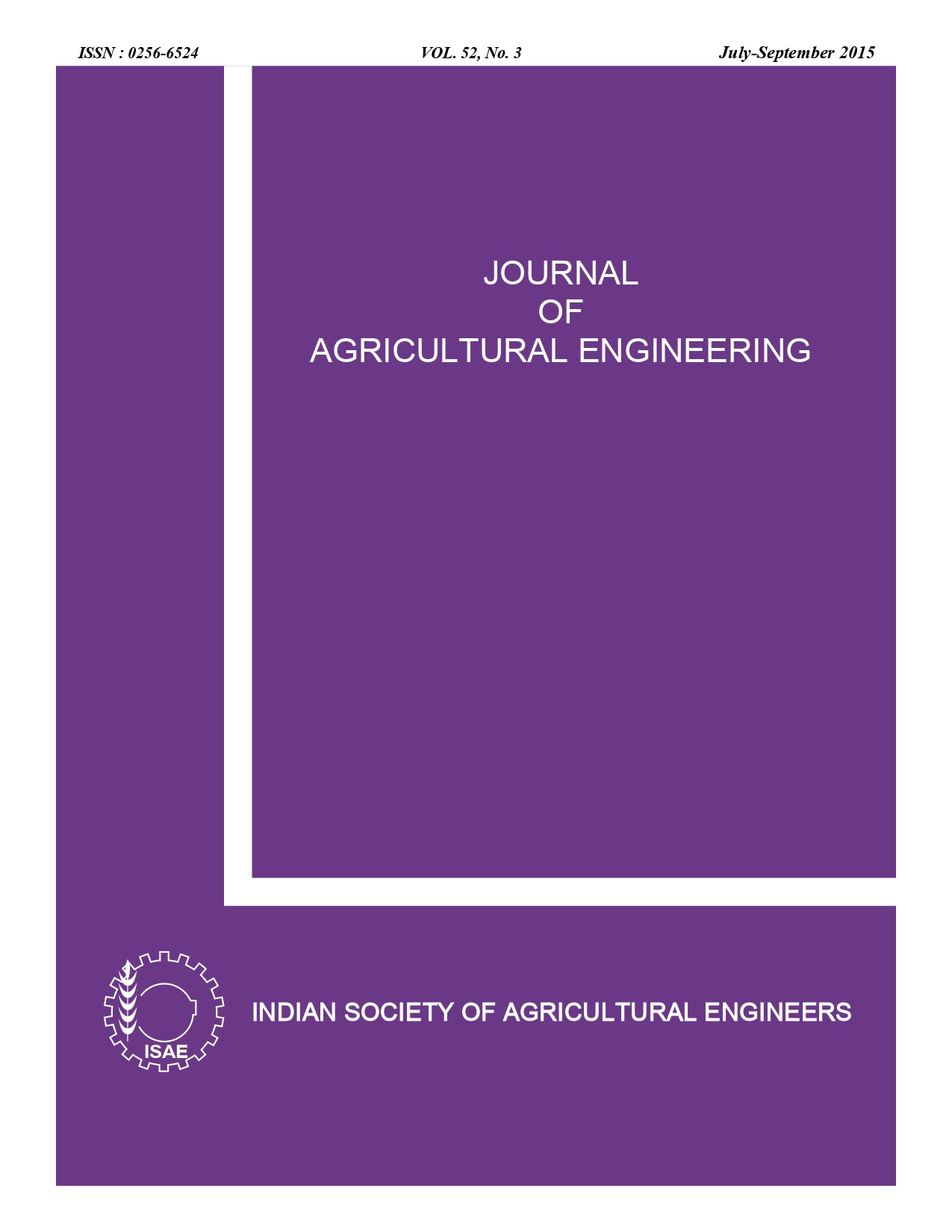Influence of Single-and Double-Stage Hammer Grinding on Quality Attributes of Turmeric Powder
DOI:
https://doi.org/10.52151/jae2015523.1579Keywords:
Turmeric, physical properties, temperature, grinding characteristics, chemical properties, colourAbstract
Physical properties of turmeric rhizomes such as length, width, thickness, geometric mean diameter, sphericity, surface area, volume, bulk density, true density, porosity, angle of repose and coefficient of friction were found to increase with increasing moisture range from 9.9-17.6 % (d.b). A comparative study was conducted to observe influence of single- and double-stage hammer grinding on average particle size, volume surface mean diameter, mass mean diameter and volume mean diameter of ground turmeric powder. The average temperature of turmeric powder was in the range of 38o C to 54o C and 35o C to 48o C for single-stage and double-stage hammer grinding, respectively. Comparatively finer powder was made by double-stage hammer grinding. Turmeric powder ground with double-stage grinding had volatile oil, curcumin and oleoresin retention ranging from 75-80%, 72-75% and 85-90%, respectively, at different moisture contents. Turmeric powder obtained from double-stage hammer grinding retained 15-25% more volatile oil, oleoresin and curcumin of active compounds as compared to single-stage hammer grinding. Browning index and yellowness index were superior in double-stage hammer grinding
References
Adagale P V; Unde P A; Hashmi S I; Raheem A. 2010. Effect of different particle sizes of jaggery powder on storability. Carpathian J. Food Sci. Technol., 2(2), 20-24.
Balasubramanian S; Sharma R; Vijay S R. 2011. Effect of moisture content and feed rate on size reduction of pearl millet. J. Food Sci. Eng.,1, 93-99.
Barnwal P; Kadam D M; Singh K K. 2012. Influence of moisture content on physical properties of maize. Int. Agrophys., 26, 331-334.
Barnwal P; Mohite A M; Singh K K; Kumar P. 2014. Selected physico-mechanical characteristics of cryogenic and ambient ground turmeric. Int. Agrophys., 28, 111-117.
Burubai W; Etekpe G W. 2014. Particle size characterization of garri powder. Adv. J. Agric. Res., 2(12), 197-202.
Buttery R G; Gudgani D G; Ling L C. 1973. Some consideration of volatile oil of organic flavour compounds in foods. J. Agric. Food Chem., 21, 198-201.
Coskuner Y; Karababa E. 2007. Physical properties of coriander seeds. J. Food Eng., 80, 408-416.
Gopalakrishnan M; Luxmi Varma R; Padmakumari K P; Symon B; Umma H; Narayanan C S. 1991. Studies on cryogenic grinding of cardamom. Indian Perfumer., 35(1), 1–7.
Gupta R K; Kumar P; Sharma A; Patil R T. 2011. Colour kinetics of aonla shreds with amalgamated blanching during drying. Int. J. Food Prop., 14(6), 1232-1240.
Handerson S M; Perry R L. 1982. Agricultural Process Engineering. AVI Publ. Co .Inc, West Port, Connecticut, 238-247.
Jain R K; Bal S. 1997. Properties of pearl millet. J. Agric. Eng. Res, 66, 85–91.
McCabe W L; Smith J C; Harriot P. 1985.Unit Operations of Chemical Engineering. 4th Ed., Mc. Graw-Hill, New York, 153-167.
Meghwal M; Goswami T K. 2010. Cryogenic grinding of spices is a novel approach whereas ambient grinding needs improvement. Cont. J. Food Sci. Technol., 4(3), 24 – 37.
Mohsenin N N. 1986. Physical Properties of Plant and Animal Materials. 3rd Ed., Gordon and Breach, New York, 682-711.
Mollazade K; Ahmadi H; Khorshidi J; Rajabipour A; Mohtasebi S S. 2009. Moisture-dependent physical and mechanical properties of cumin (Cuminumcyminum L.) seed. Int. J. Agric. Biol. Eng., 2, 49-56.
Perry J S; Hall C W. 1965. Mechanical properties of pea bean under impact loading. Trans. Am. Soc. Agric. Eng., 8(2), 191-195.
Sahay K M; Singh KK. 2004.Unit Operation of Agricultural Processing.Vikash Publishing House Ltd., New Delhi, 150-320.
Saxena R; Saxena S N; Barnwal P; Rathore S S; Sharma Y K; Soni A. 2012. Estimation of antioxidant activity, phenolic and flavonoid content of cryo and conventionally ground seeds of coriander (Coriandrumsativum L.) and fenugreek (Trigonellafoenum-graecumL.). Int. J. Seed Spices, 2, 83-86.
Singh K K; Goswami T K. 1999. Studies on cryogenic grinding of cumin seed. Food Process Eng., 22 (3), 175–190.
Singh K K; Goswami T K. 2000.Thermal properties of cumin seed. J. Food Eng., 45, 181-187.
Sogi D S; Sharma S; Obrai D P S; Wani I A. 2010. Effect of extraction parameters on curcumin yield from turmeric. J. Food Sci. Technol., 47, 300-304.
Spices Board Statistics. 2013. Spices Board, Cochin, India, 54-57.
Tabatabaeefar A. 2003. Moisture-dependent physical properties of wheat. Int. Agrophys., 17, 207–211.
Tuba A K; Ilhami G. 2008. Antioxidant and radical scavenging properties of curcumin. Chem-Bio Interact., 174(1), 27–37.
Visvanathan R; Varadharaju N; Gothandapani L; Sreenarayanan V V. 1990. Effect of moisture content on angle of repose and bulk density of selected foodgrains. J. Food Sci. Technol., 27, 133-135.
Yurtlu Y B; Yesiloglu E; Arslanoglu F. 2010. Physical properties of bay laurel seeds. Int. Agrophys., 24, 325-328.














